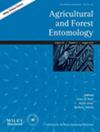Effects of temperature on the survival of spotted lanternfly active life stages when held without food
IF 1.8
3区 农林科学
Q2 ENTOMOLOGY
引用次数: 0
Abstract


温度对无食物条件下斑灯萤活跃生命阶段存活率的影响
斑灯蝇,Lycorma delicatula White(半翅目:Fulgoridae),是一种入侵性东南亚跳虫,最近被引入美国东部,通过 "搭便车 "在车辆和货物上沿着人类交通走廊传播。为了更好地了解移动生命阶段在移动过程中的建立风险,了解斑灯蝇移动生命阶段在不同温度下没有食物和水的情况下能存活多长时间至关重要。这项工作报告了斑灯蝇第一、第二和第三龄若虫和成虫在 10-30°C 温度范围内没有食物的情况下的存活情况。在温度<30°C时,第一龄若虫的存活时间长于第二龄或第三龄个体。除 10 和 25°C 外,雌性成虫的存活时间比雄性成虫长约 1 天。在没有食物的情况下,在评估的温度范围内,99% 的雌雄成虫预计会在不到一周的时间内死亡。初生个体最小,存活时间最长,随着温度的升高,它们的存活率呈指数下降。本文提供的数据将为评估各种路径上运输的斑灯蝇活动生命阶段的存活风险提供依据。
本文章由计算机程序翻译,如有差异,请以英文原文为准。
求助全文
约1分钟内获得全文
求助全文
来源期刊

Agricultural and Forest Entomology
农林科学-昆虫学
CiteScore
3.60
自引率
6.20%
发文量
66
审稿时长
>24 weeks
期刊介绍:
Agricultural and Forest Entomology provides a multi-disciplinary and international forum in which researchers can present their work on all aspects of agricultural and forest entomology to other researchers, policy makers and professionals.
The Journal welcomes primary research papers, reviews and short communications on entomological research relevant to the control of insect and other arthropod pests. We invite high quality original research papers on the biology, population dynamics, impact and management of pests of the full range of forest, agricultural and horticultural crops.
 求助内容:
求助内容: 应助结果提醒方式:
应助结果提醒方式:


